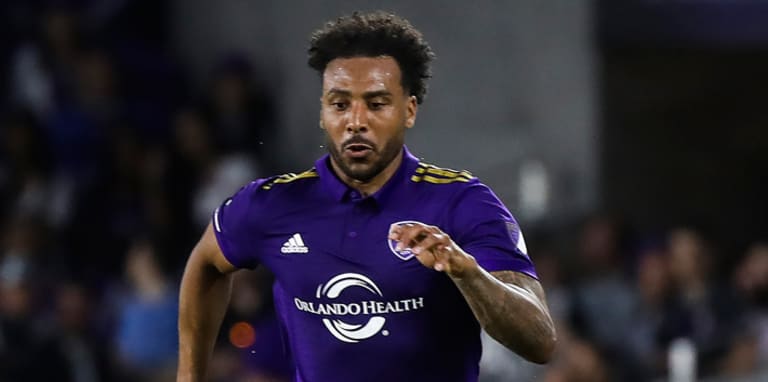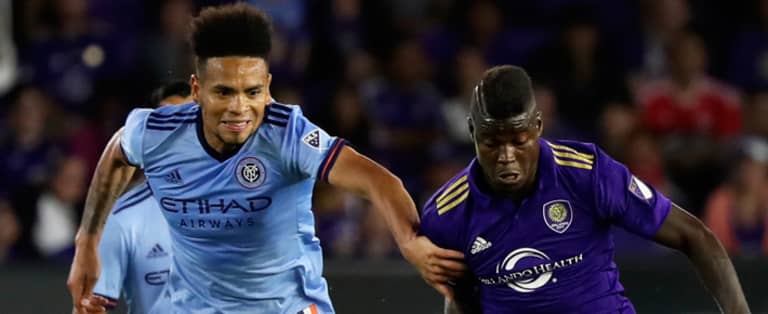Entire popular histories of careers and seasons and games often collapse into a single flashpoint. Zinedine Zidane’s headbutt. Landon Donovan’s goal against Algeria. Hungary’s tactical masterclass in a 6-3 win over England in 1953 on a single afternoon at Wembley Stadium.
Kaká's injury will perhaps not quite be as toweringly monumental as all that. Ruled out for six weeks after Orlando City SC’s opener, the Brazilian maestro faces some time on the shelf after getting just 11 minutes in the season opener against New York City FC before limping off with a hamstring strain. But his injury does represent the single most important flashpoint experienced by any team during the opening weekend, and it’ll define Orlando City’s next month and a half at the very least.
To know where Orlando City is going without Kaká, at least in the interim, you need to know where it expected to go with him.
Tactics vs. NYCFC
Orlando City coach Jason Kreis rose to prominence at Real Salt Lake riding the 4-4-2 diamond, but his time in Orlando has been more of a tactical mixed bag. Different auspices, different tactics. After some experimentation in the preseason, Orlando City rode out of its castle on Sunday in what certainly looked like a 4-2-2-2 on paper, with Kaká arrayed on the left flank, Matias Perez Garcia on the right and a two-striker set with Cyle Larin as the center of gravity and the speedier Carlos Rivas buzzing NYCFC’s tower.
The neon lettering attached to this formation was that Orlando City planned on exploiting width and crashing balls into the box for its two Odd Couple forwards. But the subtext was writ large underneath Kaká’s tactical role in particular. The 4-2-2-2 is an intriguing setup because it both allows teams to press and turns the central channel into the middle of a dance circle. Attackers can essentially jump into that central jet stream whenever they see an opportunity. The uncertainty it creates for defensive midfielders generates headaches.
Kaká’s role, even in the 10 minutes we got to see, was to jump into the middle as much as possible while listing to the left. In more ponderous moments of possession, Kaka sat underneath Larin and Rivas, and in transition he ran the flank and gradually pulled inside to link up with the forwards as left back Donny Toia overlapped to generate width. The latter case was how Kaká picked up his injury. After a barnstorming 40-yard run into the box, he tried to pull a ball drifting backward onto target. It was ultimately too far back in his stride, and after expending so much energy already, his hamstring gave out.
At least on Sunday, the event wasn’t apocalyptic. Giles Barnes, recently acquired from Vancouverin a trade for Brek Shea, came on on the left. Less than seven minutes after Kaká’s injury he put in the pinpoint cross that led to Larin’s goal. It was ultimately the only one Orlando City needed. Three points later, and here we are.
The Drop-off
As good as Barnes can be when he’s switched on, there’ll be an inevitable drop-off in that spot without Kaká. Since the Brazilian creator joined Orlando City, the club is 18-20-14 with him in the lineup and 4-5-8 without him. And per 90, their goals per game drops from 1.5 to 1.1 with Kaká sidelined. Combine that with an 11 percent drop in win percentage sans Kaká and Orlando City will have to overturn history to keep the start of its season from being slow off the blocks. Those aren’t severe numbers, but remember, Orlando City missed the playoffs by one point in 2016 and five in 2015. Margins are tight in MLS.
The potential replacement

The good news is that on his day, Barnes is capable of scoring bundles of goals. The bad news is that he’s not Kaká.
At his best with Houston and then Vancouver, Barnes was a skill-forward second striker who was never relied upon to give much to the build-up in the way of distribution (or crosses, for that matter). With the Houston Dynamo and the Whitecaps in 2016, Barnes averaged about 20 passes per game and largely existed as a predatory threat closer to goal. Kaká, the man Barnes might be about to replace on an interim basis, has so far averaged 41 passes per game in his two full seasons in Orlando. That’s the highest average of his career, anywhere, including Real Madrid and AC Milan.
So, in other words, Orlando City can count on about half the distributive numbers when Barnes is on the field at the expense of Kaká.
Barnes was quality in his 79 minutes in the sense that he contributed to the goal, but on the whole he was relatively detached from the flow of the match on the left. He was an anemic 7-of-16 passing and only even attempted four passes in the central channel Kaká loved to crash. Barnes will no doubt improve there given time with the first team in training, but considering how difficult Orlando City found it to mount breaks after Barnes’ inclusion, there might be another change in the offing.
Another option

Could Rivas be making a return to the left wing?
I think it’d be a prescient move to consider, and I’d be surprised if Kreis didn’t at least gamble with it in practice to see how it runs. As Sunday’s game wore on, Rivas gradually drifted left anyway to help pry Barnes’ possession into the box, and of Rivas’ 12 passes (yes, just 12), seven were clustered around the high left flank, and all of them were completed.
You’d essentially address two issues at once by bumping Barnes up next to Larin and shoving Rivas back out wide to use his camera-shutter speed push the transition game Kreis is so good at utilizing. He also has the option of pushing Perez Garcia inside, where he played at times in San Jose, but I think the right wing will be harder to reconcile without him on it. We could well be seeing a return to a more dynamic 4-4-2.
Either way Orlando City goes, they’re bound to sacrifice the central channel in some regard without Kaká. The Brazilian is maybe the best pure reader of the game in MLS right now, and while he doesn’t have the agility of some other pure creative influences in the league, he sees so many steps ahead. Orlando City planned to use Kaká like the Seattle Sounders often use Nicolas Lodeiro and the Montreal Impact use Ignacio Piatti: a flipped-out No. 10 with the license to pull inside. There is no like-for-like replacement for a player like that.
Orlando City is about to find out how well it can plug the gaps in the meantime.












